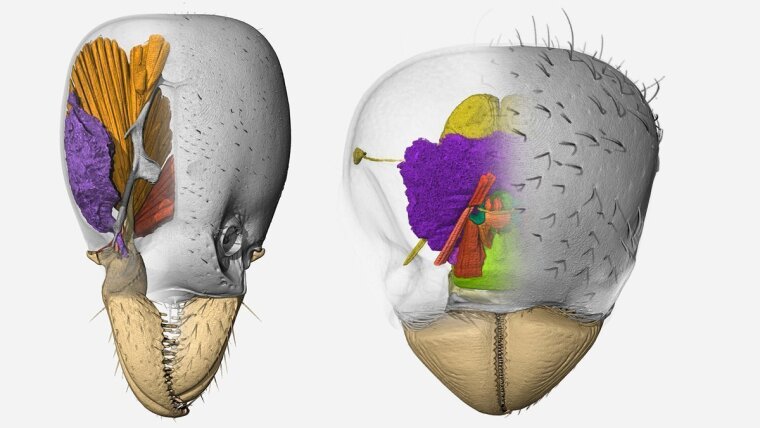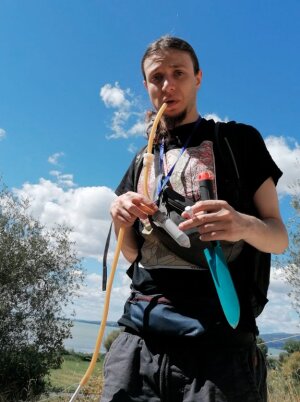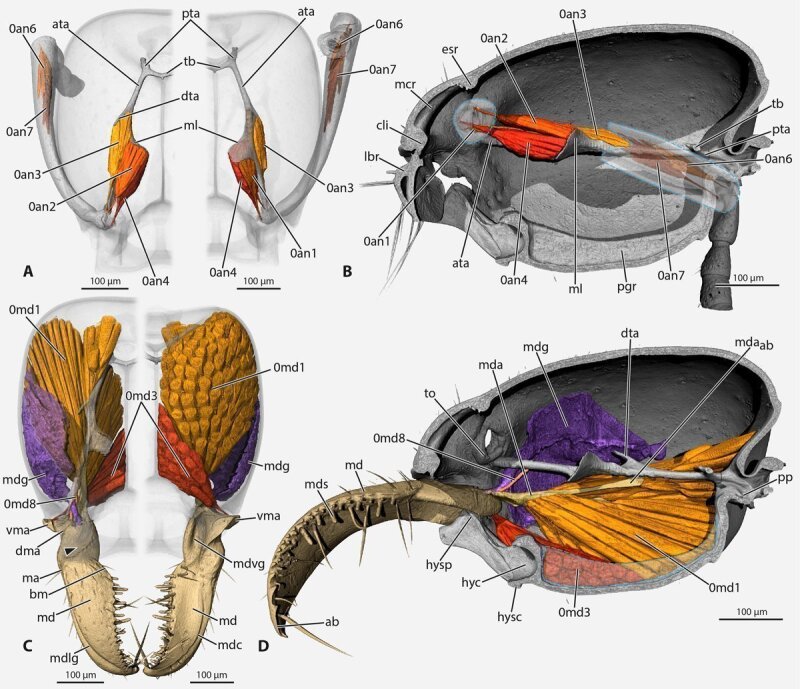
Adrian Richter
Image: Dr. Brendon BoudinotContact
Dr. Adrian Richter
Friedrich Schiller University Jena
Institute of Zoology and Evolutionary Research
Phyletisches Museum
Vor dem Neutor 1 (room 206)
07743 Jena
Germany
Tel.: +49 3641 9-49181
adrichter@gmx.de
From February 2023:
Biodiversity and Biocomplexity Unit
Okinawa Institute of Science and Technology Graduate University
Lab2 B657
1919-1 Tancha, Onna-son, Kunigami-gun
Okinawa, Japan 904-0495
Research Interest
I am an entomologist focusing ants and other hymenopterans. The research areas I am most interested in are insect morphology and evolution, as well as systematics and taxonomy. The main goal of all my research is to understand the phenotypic evolution of insects and how it shaped their past and present diversity.
Research Topics
I started my scientific work studying the morphology of female Strepsiptera. After this, I have mostly focused on the ant head and investigated this in several publications focusing on head anatomy of one or a few species. As a next step, I expanded this to analyze character evolution of ants and other Aculeata more widely to reconstruct the morphological ground plan and character transitions within the Formicidae. I have also contributed to studies on the functional morphology of ants and morphology of other Hymenoptera. Recently, I have also started incorporating paleontology in my work, investigating the anatomy of fossil ant species. In the future, I want to study morphological evolution in ants from a macroevolutionary perspective.
Research Methods
- µCT scanning and 3D reconstruction
- Scanning electron microscopy
- Histology
- Phylogenetic analysis
- Ancestral state reconstruction
Anatomy of the blind, underground ant species Protanilla lini, showing the antennal musculature (A, B) and mandibular musculature as well as mandibular gland (C, D). Colors: grey – cuticle, red/ orange – muscles, purple – gland. From Richter et al. 2021, Myrmecological News, published open access.
Image: Adrian RichterShort CV
Professional appointment
from 02/2023 Postdoctoral fellow supported by the Japanese Society for the Promotion of Science (JSPS) with Evan Economo at the Okinawa Institute of Science and Technology
Education
02/2019 – 11/2022 PhD student, Friedrich-Schiller-Universität Jena
Project title: »The Evolution of ant head morphology«. Supervisor: Rolf G. Beutel
10/2016 – 09/2018 MSc in Evolution, Ecology and Systematics, Friedrich-Schiller-Universität Jena
10/2013 – 09/2016 BSc in Biology, Friedrich-Schiller-Universität Jena
Scientific appointments
03/2019 – 08/2019 »Visiting Research Student«, Okinawa Institute of Science and Technology, Japan, Biodiversity and Biocomplexity Unit. Supervisor: Evan P. Economo
Professionel experience
15.01.1020 – present Technical assistant, Max-Planck Institute for human history, Jena
Operate µCT scanner and 3D-printer
15.01.2018 – 02/2019 Student assistant, Max-Planck Institute for human history, Jena
Operate µCT scanner and 3D-printer
10/2016 – 11/2016 Student assistant, Friedrich-Schiller-Universität Jena
Assistent in a project on beetle head morphology
Scholarships and awards
01/2020 – present Monthly scholarship of the »Evangelisches Studienwerk Villigst ev.«
(1420 € monthly)
11/2021 President’s price of the Entomological Society of America for the best student presentation at the yearly meeting 2021 (75$)
09/2020 Frontiers in Zoology Award 2019 for the best student presentation at the meeting of the DZG 2019 (300€)
09/2020 Price of the German Zoological Association for the best zoological master thesis 2019 (100€)
Media
22.02.2022 Division of labour in ants goes back over 100 million years.External link idw scientific information service.
08.04.2021 Open wide! What mandibles can teach us about ant evolution.External link Myrmecological News Blog.
02.09.2020 »Comparaison anatomique des têtes de deux espèces de fourmis: Formica et Brachyponera« Article on passion-entomologie.fr, summarizing the results of Richter et al. 2020
Scientific Reviewer
Arthropod Structure & Development; Bioinspiration & biomimetics; Biological Journal of the Linnean Society; Bulletin of Insectology; Insectes Sociaux; Science advances; Zoologischer Anzeiger.
Publications
(please see GoogleScholar External linkfor latest and use ResearchGateExternal link for full-text requests)
Richter, A., Boudinot, B.E., Yamamoto, S., Katzke, J., Beutel, R.G., 2022. The first reconstruction of the head anatomy of a Cretaceous insect, †Gerontoformica gracilis (Hymenoptera, Formicidae), and the early evolution of the ants. Insect Syst. Divers., 6(5), 4, 1–80. https://doi.org/10.1093/isd/ixac013External link
Boudinot, B.E., Richter, A.K., Hammel, J., Szwedo, J., Bojarski, B., Perrichot, V., 2022. Genomic-phenomic reciprocal illumination: †Desyopone gen. nov., an exceptional aneuretine-like fossil ant from Ethiopian amber (Hymenoptera: Formicidae: Ponerinae). Insects, 13, 796. https://doi.org/10.3390/insects13090796External link
Aibekova, L., Boudinot, B.E., Beutel, R.G., Richter, A., Keller, R.A., Hita-Garcia, F., Economo, E.P., 2022. The skeletomuscular system of the mesosoma of Formica rufa workers (Hymenoptera: Formicidae). Insect. Syst. Divers. 6, 1–26. https://doi.org/10.1093/isd/ixac002External link
Boudinot, B.E., Richter, A., Beutel, R.G., Katzke, J., Keller, R.A., Economo, E.P., Yamamoto, E., 2022. Evidence for the evolution of eusociality in stem ants and a systematic revision of †Gerontoformica (Hymenoptera, Formicidae). Zool. J. Linn. Soc. https://doi.org/10.1093/zoolinnean/zlab097External link
Boudinot, B.E., Moosdorf, O.T.D., Beutel, R.G., Richter, A., 2021. Anatomy and evolution of the head of Dorylus helvolus (Formicidae: Dorylinae): Patterns of sex‐and caste‐limited traits in the sausagefly and the driver ant. J.Mor. 282, 1616–1658.
Richter, A., Hita Garcia, F., Keller, R.A., Billen, J., Katzke, J., Boudinot, B.E., Economo, E.P., Beutel, R.G., 2021. The head anatomy of Protanilla lini (Hymenoptera: Formicidae: Leptanillinae), with a hypothesis of their mandibular movement. Myrmecol. News 31, 85–114.
Richter, A., Schoeters, E., Billen, J., 2021. Morphology and closing mechanism of the mandibular gland orifice in ants (Hymenoptera: Formicidae). J. Morph 282, 1127–1140.
Wöhrl, T., Richter, A., Guo, S., Reinhardt, L., Nowotny, M., Blickhan, R., 2021. Comparative analysis of a geometric and an adhesive righting strategy against toppling in inclined hexapedal locomotion. J. Exp. Biol. 224, jeb242677.
Beutel, R.G., Richter, A., Keller, R.A., Hita Garcia, F., Matsumura, Y., Economo, E.P., Gorb, S.N., 2020. Distal leg structures of the Aculeata (Hymenoptera): A comparative evolutionary study of Sceliphron (Sphecidae) and Formica (Formicidae). J.Mor. 281, 737–753.
Richter, A., Garcia, F.H., Keller, R.A., Billen, J., Economo, E.P., Beutel, R.G., 2020. Comparative analysis of worker head anatomy of Formica and Brachyponera (Hymenoptera: Formicidae). Arthr. Syst. Phyl. 78, 133–170.
Pohl, H., Hammel, J.U., Richter, A., Beutel, R.G., 2019. The first fossil free-living late instar larva of Strepsiptera (Insecta). Arthr. Syst. Phyl. 77, 125–140.
Liu, S.-P., Richter, A., Stoessel, A., Beutel, R.G., 2019. The mesosomal anatomy of Myrmecia nigrocincta workers and evolutionary transformations in Formicidae (Hymenoptera). Arthr. Syst. Phyl. 77, 1–19.
Richter, A., Keller, R.A., Rosumek, F.B., Economo, E.P., Hita Garcia, F., Beutel, R.G., 2019. The cephalic anatomy of workers of the ant species Wasmannia affinis (Formicidae, Hymenoptera, Insecta) and its evolutionary implications. Arthropod Struct. Dev. 49, 26–49.
Wipfler, B., Kočárek, P., Richter, A., Boudinot, B., Bai, M., Beutel, R.G., 2019. Structural features and life habits of †Alienoptera (Polyneoptera, Dictyoptera, Insecta). Palaeoentomology 2, 465–473.
Beutel, R.G., Yan, E., Richter, A., Büsse, S., Miller, K.B., Yavorskaya, M., Wipfler, B., 2017. The head of Heterogyrus milloti (Coleoptera: Gyrinidae) and its phylogenetic implications. Arthr. Syst. Phyl. 75, 261–280.
Richter, A., Wipfler, B., Beutel, R.G., Pohl, H., 2017. The female cephalothorax of Xenos vesparum Rossi, 1793 (Strepsiptera: Xenidae). Arthr. Syst. Phyl. 75, 327–347.
Conference Abstracts
11/2021 A glimpse into Cretaceous ant cephalic anatomy The head of †Gerontoformica from Burmese amber (Hymenoptera, Formicidae). 12 minutes talk at the annual meeting of the Entomological Society of America (online).
09/2021 A glimpse into Cretaceous ant cephalic anatomy The head of †Gerontoformica from Burmese amber (Hymenoptera, Formicidae). 6 minutes talk at the annual meeting of the German Zoological Association (online).
02/2021 Morphology and closing mechanism of the mandibular gland orifice in ants (Hymenoptera: Formicidae). 12 minutes talk at the 2. Young Reasearcher Meeting Morphology of the German Zoological Association (online)
09/2019 The Evolution of Head Morphology in Ants: Analysis of an Understudied Character Complex. Two 12 minutes talks at the annual meeting of the German Zoological Association in Jena and the Dresden meeting on insect phylogeny, Dresden, Germany.

